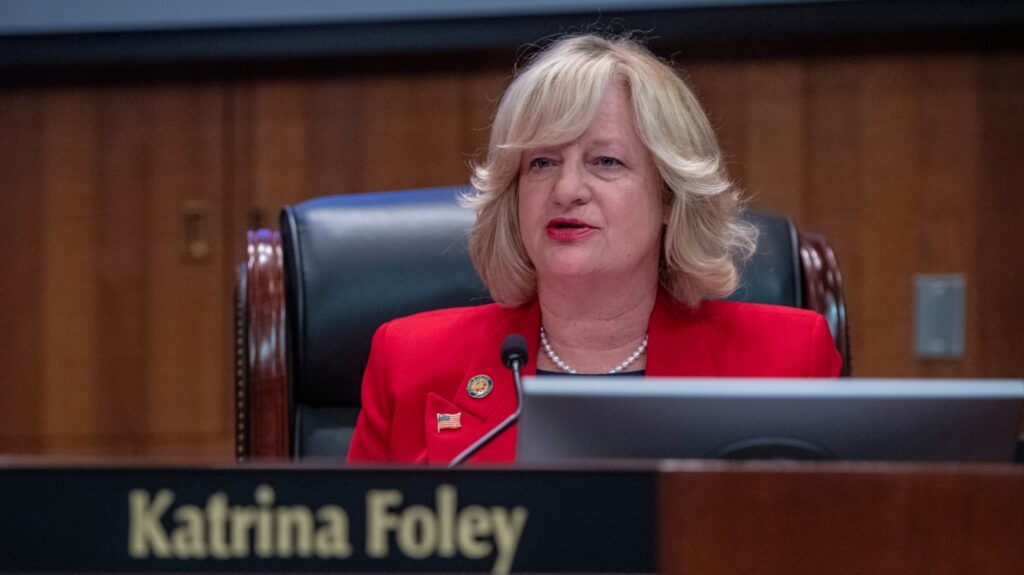
Orange County spends more than $1.6 billion a year on homeless facilities, programs and services, and some of the county’s 34 cities also are spending millions – but unless local officials devise a comprehensive, countywide strategy focused on lasting solutions, they may be stuck on a hamster wheel: solving the same problems over and over, community by community.
That was the message of a series of panel discussions held Wednesday, hosted by Orange County Supervisor Katrina Foley, that featured homeless service providers from the county and nonprofits and several OC city mayors who have dealt with the issue.
While state dollars have been flowing into Orange County – including tens of millions to convert old motels into permanent housing – only its largest cities, Anaheim and Santa Ana, get direct funding from the state to address homeless, mental health and addiction issues.
Three mayors – Costa Mesa’s John Stephens, Laguna Beach’s Sue Kempf and Santa Ana’s Vicente Sarmiento – described the frustration of trying to clean up encampments and get people shelter and services, sometimes amid criticism from the public and a lack of funding or cooperation from the county.
Costa Mesa opened a permanent “bridge shelter” last year. In addition to the $11 million it spent to buy the property and develop the shelter, Stephens said the city spends another $3.5 million a year on homeless programs. A neighbor city, Newport Beach, chipped in for the building and pays annually to reserve beds for homeless from its streets.
But other leaders said more communities need to share the load. Kempf said Laguna Beach has the only low-barrier shelter in south county, and today only about 15% of people who stay there have ties to the community. Previously, nearly 80% had some connection to Laguna.
Ken Gominsky, who retired from the Santa Ana Police Department and now oversees that city’s homeless services, said although the county is home to multiple National Guard armories, the one in Santa Ana is used annually as a cold weather homeless shelter.
“The city of Santa Ana should not be the only city that gets this opportunity,” he said.
Panelists and the handful of people in the audience Wednesday heard from Colleen Rozillis of auditing firm Moss Adams, who was hired to calculate county spending on homeless issues. Rozillis said Orange County spends about $590 million a year directly on homeless services, as well as another $362 million on related mental health programs, $287 million on health care, $271 million on housing, and another $140 million on addiction and human services.
While the county does track the occupancy of shelter beds and the use of housing vouchers for homeless people, Rozillis said it lacks an across-the-board system that would allow county agencies, and their many city and nonprofit partners and contractors, to keep uniform data and measure progress on their goals.
Katherine White of Wound Walk OC, a nonprofit that provides outreach and basic medical care for people living on the streets, suggested mental health outreach continues to lag demand among homeless people. She pointed to a survey commissioned by Foley, which reached more than 200 unhoused people in central Orange County and found that even though more than half the respondents said they had been diagnosed with a mental health problem only about 44% had been offered mental health services as part of a shelter or housing program.
Also, about 80% of the respondents in that same survey had never been offered medical detox or substance rehab assistance when entering a shelter or housing program – but 30% said they would enter such a program right away if it were offered.
A recurring theme during the three-hour hearing was that communities found the most success addressing their homeless issues when they formed collaborative teams that could meet a variety of needs, or when they banded together to create multi-city programs, like the new “Project Hope,” a social services dispatching center that is a joint effort of 14 north and central county cities.
Panelists also shared the need for more dedicated housing for veterans and young people facing homelessness, as well as more mental health and detox services and affordable housing with support services generally.
Foley said she hopes to focus on directing funding to cities for their homeless efforts. She also hopes to help create a strategic plan with regional metrics and goals, and to help build more housing with existing resources, such as the state’s Project Homekey program.
“We’re doing a good job of funding services and reacting to needs, but we’re not funding outcomes,” she said.
Related Articles
Mary’s Kitchen holds ‘garage sale’ as city lays out plan to replace nonprofit’s services
New homeless shelter in Santa Ana won’t open as scheduled
